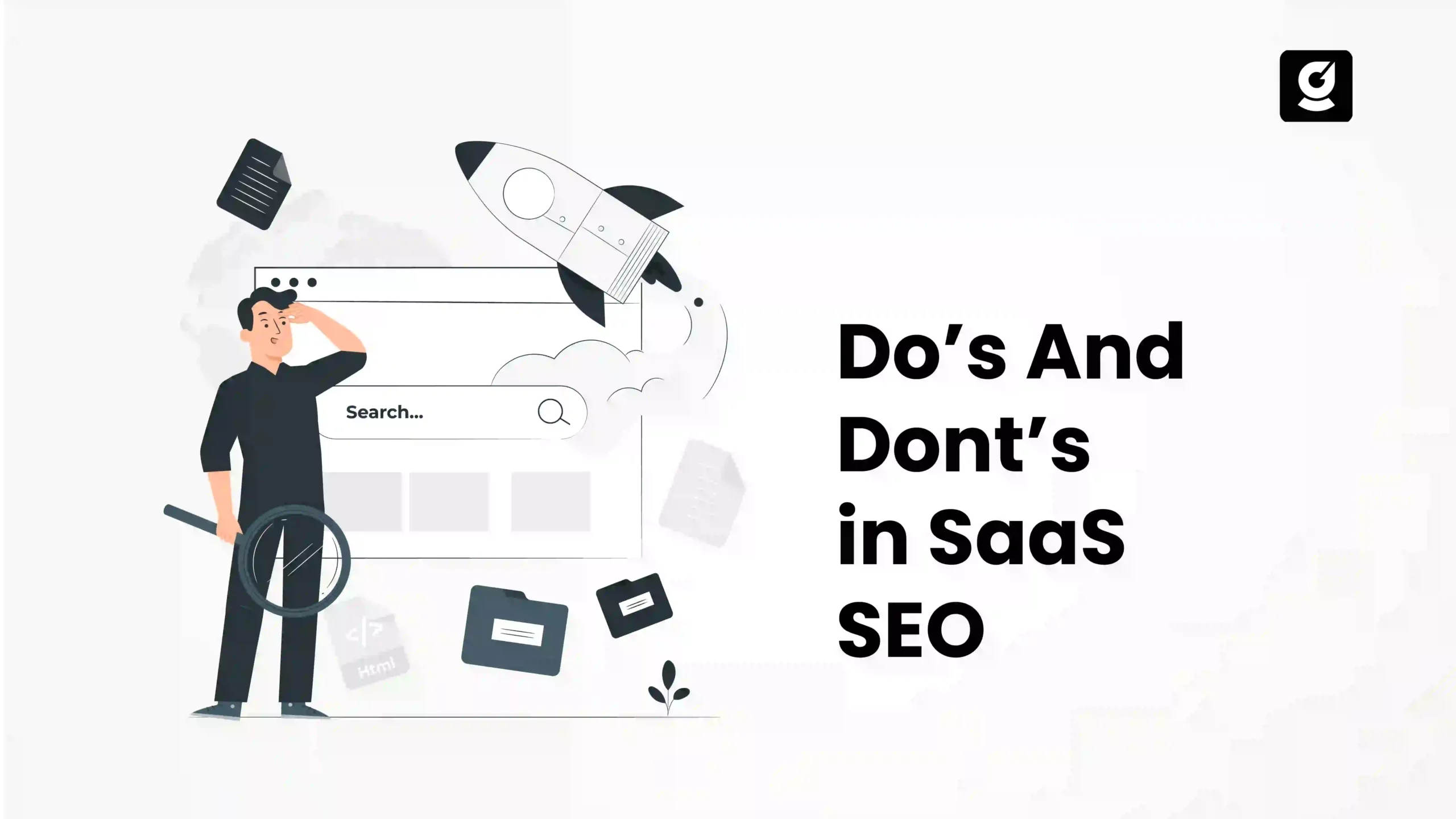So, you’ve invested considerable time and effort into developing your B2B SaaS product.
Now, the question is, does it reach your intended audience?
That can be achieved by proper Search Engine Optimization (SEO) strategies. A proper SEO strategy can help in ranking your business products and services visibility. It helps you get in the first position ahead of your competitors in SERPs.
However, achieving this top rank in search results is challenging, especially within the SaaS industry. So you have to jump up all the problems that come your way in SEO.
In this blog, you will learn the dos and don’ts of SaaS SEO strategies and how partnering with a specialized SaaS SEO agency can be easy.
The Dos Of SEO Practices In SaaS

1. Always Focus on Your User Experience
User experience (UX) is important in your SaaS SEO strategy. Search engines always prioritize websites that provide a positive user experience. It includes fast loading times, easy navigation, and mobile-friendly design.
You must ensure that your website is user-friendly, which helps improve your SEO and enhance customer satisfaction and retention in your business.
- Fast loading times
Google always considers the speed of your website page. If your website page loads quickly, that helps you rank in SERPs. If your website loads slowly, you can try elements like optimizing images, minifying codes (CSS, JavaScript, HTML), and using a content delivery system.
- Easy navigation
Easy navigation helps users find what they are looking for easily. It enhances the overall experience and increases conversion, too. You can improve navigation by clear menu structuring, breadcrumb navigation, and including a search bar on your website.
- Mobile-friendly design
Nowadays, most people browse on their mobile phones, and that is important for making your website mobile-friendly. Google uses mobile-first indexing, which means it uses the mobile version of the site content for indexing and ranking. You can improve it with responsive design, touch-friendly elements, and optimized mobile content.
Suggested Read: 7 Top SEO Factors For Your SaaS Website [2024]
2. Proper Keyword Research
Keyword research is the basis of any successful SaaS SEO strategy. You can identify the right relevant keywords from a keyword research tool. This tool helps you understand what your potential customers are searching for. It will help you optimize your website content accordingly.
Use keyword research tools like SuiteJar, Google Keyword Planner, or Moz. You can find keywords with high keyword volume and low competition. However, you have to focus on long-tail keywords that are specific to your SaaS product for better targeting.
You can make a sheet of important and relevant topics based on what you know about your business.
- Start By Finding The Topics That Are Relevant To Your Audience
These should be broad categories that reflect the primary areas of your product or service offerings.
- Fill In Those Topic Buckets With Keywords
Once you have your core topics, start filling each topic bucket with specific keywords. These keywords or queries are the terms that potential customers use when searching for data related to those topics.
- You Have To Understand How Intent Affects Keyword Research And Analyze Accordingly
Understanding the intent behind keywords is crucial for effective keyword research. User intent is called what the searcher is hoping to accomplish with their query.
- Research-Related Search Terms
You can research the related search terms that help you discover additional keywords. You can use a tool and search for the main keyword that intends your audience. You will now see some of the related terms that come with the main keyword. You can look at the Google ‘people also ask and ‘related searches for getting keywords.
- Use Keyword Research Tools To Your Advantage
There are many keyword research tools that provide you with keyword ideas and traffic insights. Use the tool appropriately and get search volume, keyword difficulty and the competition of the keyword. Set up a list of these keywords with the data and take those into your SEO strategy.
Further Read: Mastering B2B SaaS SEO in 2024
3. Optimize for On-Page SEO
Next, you have to optimize your On-page SEO. There are so many on-page seo elements that help you in your seo strategy. This strategy involves optimizing individual pages to rank higher and get more traffic. These are the few points that you have to consider when doing SaaS SEO.
- Title Tags and Meta Descriptions: Add each webpage with a meta title and meta description. You can include your target keywords, too.
- Header Tags: Use H1, H2, and H3 tags to structure your content, making it easier for search engines to understand.
- URL Structure: Use clear and descriptive URLs that include keywords.
- Image Optimization: Use alt tags for images and compress them to improve page load speed.
Further Read: Ultimate On-Page SEO Checklist for 2024
4. Optimize Your Website Content
High-quality content is very important to attracting and retaining visitors. You have to update your blog with informative articles, how-to guides, and industry insights. Write well-researched content that is engaging and addresses the pain points of your target audience. Including keywords naturally within the content helps improve its visibility in search engines.
Here are the 7 steps that you can follow when optimizing your SaaS SEO content,
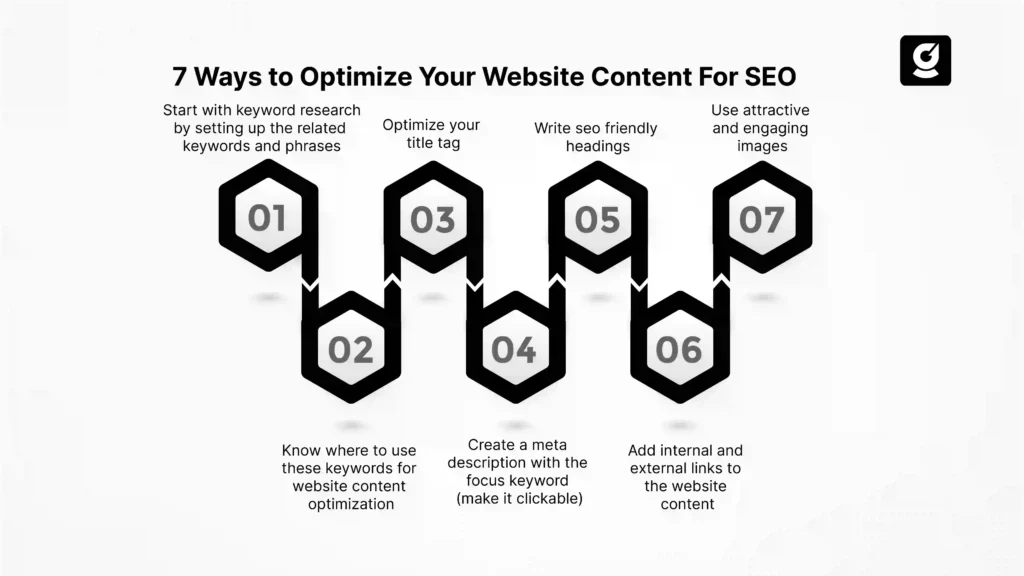
- Start With Keyword Research By Setting Up The Related Keywords And Phrases: First, it is necessary to do a proper keyword research to select the most suitable keywords and phrases.
- Know Where To Use These Keywords For Website Content Optimization: Place these keywords strategically in your website content to increase optimization efforts.
- Optimize Your Title Tag: Title tags should be made easy and simple and should describe what the content of the page is about.
- Create A Meta Description With The Focus Keyword (Make It Clickable): Aim to develop a meta description with a clickable text featuring the focus keyword to enhance CTR.
- Write Seo Friendly Headings: Create meaningful headings, which will also be optimized for search engine queries to help readers navigate the content.
- Add Internal And External Links To The Website Content: Ensure that you have both internal and external linkages to enhance content interconnectivity and credibility.
- Use Attractive And Engaging Images: It is also important to use interesting and bright images in order to engage and sustain the interest of the audience.
Further Read: Ultimate Guide To B2B SaaS Content Marketing
5. Build Quality Backlinks
Backlinks are links from other reputable websites and are a strong indicator of your site’s authority and credibility. Focus on building quality backlinks through:
- Guest Blogging
Write articles for reputable industry blogs. This strategy not only gets you backlinks but also positions you as an authoritative website in your niche. You can do guest blogging by,
- Identifying relevant and reputable blogs in your industry that accept guest blogs. So many SEO tools can help you get high-authority sites.
- You can propose some topics that match the host’s audience with unique and valuable content.
- Follow the host’s blog submission guidelines to increase your chances of having your post accepted.
- Partnerships
Collaborate with other businesses for mutual link exchanges. This partnership includes exchanging backlinks, co-coauthoring content, or engaging in some marketing efforts. This is how you do it for building partnerships; first, look for businesses or websites that complement your offerings.
You have to set up a clear proposal highlighting how both parties can benefit from the partnership. You can also collaborate with content pieces like blog posts, webinars, and ebooks that provide value to both audiences. Try to include backlinks to each other’s websites.
- Content Marketing
Create shareable content that naturally attracts links from other websites. Always remember to focus on creating quality and shareable content. you can follow these steps in your content marketing to get proper backlinks
- create high-quality content
- research thoroughly and add the origins of the content
- make promotion and outreach
- engage with communities
- update and repurpose your content
The Don’t of SEO Practices in SaaS
1. Don’t Engage in Keyword Stuffing
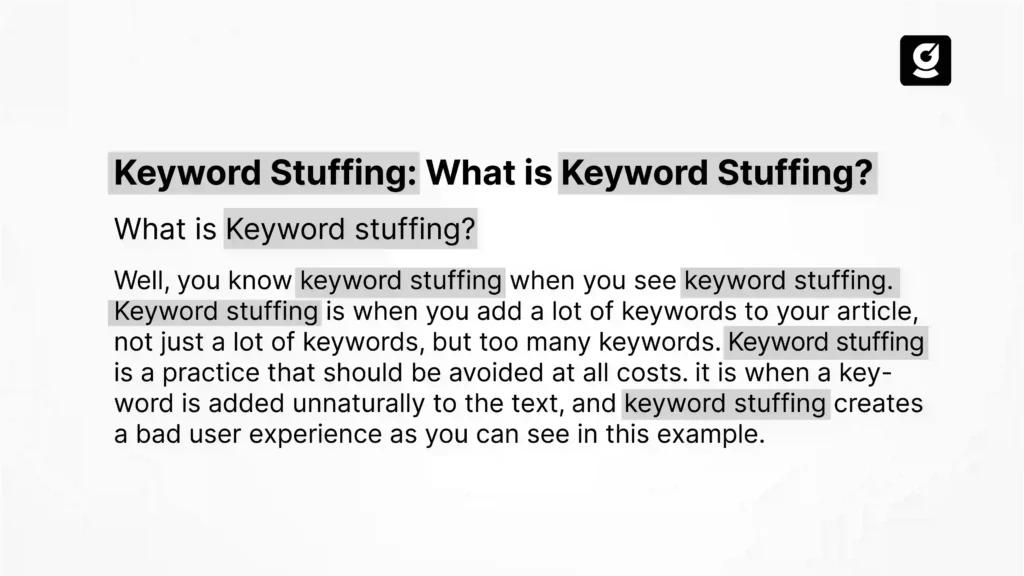
Keyword stuffing or overusing keywords in your content in an attempt to manipulate search rankings. This keyword stuffing can do more harm than good to your website. All the search engines are smart enough to recognize this problem, but they may penalize your site for it. Always focus on creating high-quality content that incorporates keywords naturally.
Keyword stuffing is an unnatural process in which you use the same keyword multiple times in content. This is a very bad approach in SEO, but it makes your website trustworthy.
You can easily avoid these keyword stuffing in your content with some simple steps,
- Proper Keyword research
The first thing we have to do is develop a proper keyword research strategy. There are many keyword research tools, such as SuiteJar, Google Keyword Planner, pr Ahrefs, to identify relevant keywords. And always remember to focus on a mix of primary and secondary keywords. You can include long-tail keywords that have a proper keyword volume and are less competitive.
- Write for Humans First, Search Engines Second
The next step is creating website content that is ultimately for your audience. This content has to be informative and engaging for your targeted audience. Add the keywords that fit naturally within the content text. You can prioritize readability and user experience over keyword frequency. Human First is the only motto that we use when writing content for search engines, so keep that in mind and write the content according to that.
- Use Synonyms and Related Terms of the Keyword
If you have to add the keyword to the content, you can add synonyms of the word. This approach helps avoid repetitive keyword usage. Also, it maintains the relevance of your seo content. It will allow the client to understand the content easily without overreading the same keyword. This way, you can enhance the semantic richness of your SEO content.
- Check Keyword Density For The Page
The next step is to keep the keyword density between 1-2%. The density will change according to the total word count, so keep that in mind. There are many tools for monitoring keyword usage and ensuring it’s not excessive for the content.
- Review Your Content
After writing the seo content, review your content thoroughly. You can then ensure keywords are used naturally and that the content flows smoothly. Read the content twice or thrice to check if it has any continuation problems. Reviewing helps you with unwanted keyword stuffing and improves overall quality.
Also Read: 15 Do’s And Don’ts Of Content Marketing Strategy & Writing
2. Ignoring Technical SEO
Technical SEO involves optimizing your website’s technical elements. This will ensure that Google-like search engines can crawl and index your website effectively.
Must Look Out technical SEO elements include:
- Site Speed: It is a ranking factor in your website. It will directly affect user experience on your website. A slow-moving site can lead to higher bounce rates and lower engagement, which often negatively impacts your SEO efforts.
- XML Sitemap: An XML sitemap acts as a roadmap for search engines. It helps them discover and index your website’s content more efficiently. Unfortunately, many websites either lack a sitemap or are outdated.
- Robots.txt File: The robots.txt file is a simple text file but has proper functions. It instructs search engine crawlers which pages they can or cannot access. If these files are misconfigured, they can lead to essential pages being de-indexed or irrelevant pages being crawled.
- HTTPS: Securing your website with HTTPS helps you build trust with proper users and improves your search engine rankings.
- Canonical Tags: Canonical tags help prevent duplicate content on your website. It issues by indicating the “preferred” version of a webpage. You have to properly use the canonical tags in your website. It helps in ensuring that search engines understand which URL to index and rank.
3. Neglecting Mobile Optimization
Mobile optimization is neglecting many people; they think that it is less important. As people are overusing mobile phones for everything, it is very important in seo. When you give no importance to this, it will lead to poor user experience, decreased engagement, and low conversions.
You can easily configure this in 3 steps,
- Responsive Design: It is a web design approach that ensures your website adjusts to any screen size. It has to fit properly on desktops and smartphones.
- Flexible Grid Layouts: A flexible grid system scales proportionally to any screen size.
- Media Queries: Implement CSS media queries to apply different styles. It can be based on the device’s characteristics (screen width, height, orientation, and resolution).
- Images and Videos: Use relative units and max-width properties to ensure that pictures and videos automatically resize to fit the screen.
- Dynamic Serving: This is called serving different HTML and CSS codes based on the user’s device. It uses the same URL for both desktop and mobile versions but delivers different content depending on the device.
- Optimized Content: You must create optimized versions of your site’s content for different devices.
- Separate CSS Files: Use separate CSS files for mobile and desktop versions specifically for each device.
Suggested Read: Mobile Conversions Rates: Optimizing User Experience and Driving Action
4. Separate URLs
The separate URL method involves creating different URLs for your website’s mobile and desktop versions.
- User Agent Detection: Implement scripts to detect the user’s device. And you can redirect them to the appropriate URL
- Canonical and Alternate Tags: Use rel= “canonical” tags on the mobile pages to point to the corresponding desktop pages and rel= “alternate” tags on the desktop pages to point to the mobile versions.
- Optimized Content and Layout: You can create and optimize the mobile version separately from the desktop version.
5. Buying Backlinks
While building backlinks is important, buying them is a bad practice that can lead to penalties from search engines to your website. You can focus on earning backlinks naturally through high-quality content and other outreach efforts.
Google itself does not push these buying links. If they see some backlinks like this, they will discount the links and penalize your website.
You can easily earn your backlink naturally by following these methods.
- Create Quality Content
You can write quality content for your website and publish it. You can add research ideas, surveys, or other case studies that show the trustworthiness of the content. So, other websites are likely to link to your research that gives you a backlink. Write in-depth guides, well-informative content, infographics, and visual content.
- Guest Blogging
In the guest blogging process, you have to find authoritative content, such as blogs or articles, in your niche. And they have to accept your quality guest posts, too. You can easily write for this site and get quality backlinks.
- Relationship Building
Connect with influencers and thought leaders in your industry. Also, engage in forums, social media groups, and other communities. These can help you build relationships and get backlinks.
- Try Broken Link Building
Use any broken link checker tool to find broken links on relevant websites. Simply contact the website owner and inform them about the broken links. You can even suggest replacing links with links to your relevant content.
- Press Releases
Press releases are another strategy for earning quality backlinks. You have to write and distribute press releases about significant company news, product launches, or events. Press releases can attract media coverage and backlinks from news sites.
Bonus Tip: Hire a Specialized SaaS SEO Agency
The bonus tip is to hire a professional SaaS SEO agency for your business. This team will bring proper expertise, resources, and a proven track record to your company. when selecting a SaaS SEO agency, you have to consider some points like,
- Services the agency offers
- Results of the company
- Experience of the agency
- Pricing and deliverables
- Step-by-step process in seo
Whether you are thinking of a b2b saas seo agency, you can hire growth.cx as your SaaS SEO agency.
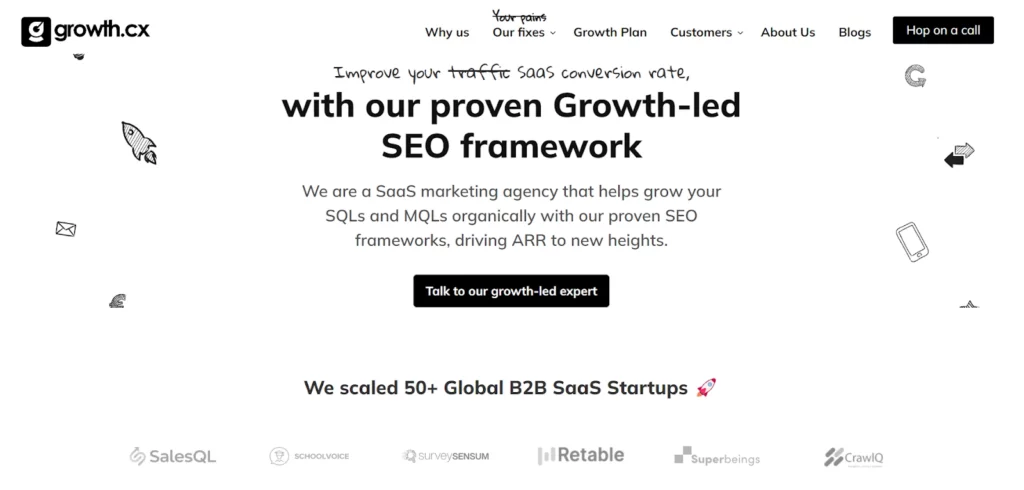
The entire SaaS SEO team has the complete mindset and commitment to delivering quality results for your seo strategy. They will implement the seo strategies one by one by tailoring solutions with industry trends. growth.cx has 50+ SAAS clients with as many clients with proven results in rankings and conversions.
When it comes to b2b saas seo agency, they have a proper seo team that is dedicated to their work.
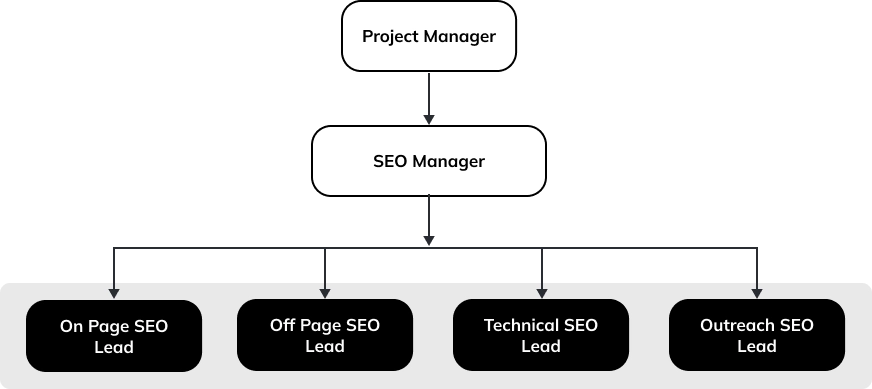
When you hire growth, cx b2b saas seo agency, you will get a complimentary bundle that no other agencies are providing. At growth.cx, we work to:
- Bring relevant traffic to your website.
- Increase your SQLs and M.Q.L.s.
- Boost your website’s Pagerank and Domain Authority.
- You are an authority in your industry.
- Conversion rates to skyrocket your MRR/ARR.
Conclusion
Getting to know what SEO strategies work in your favor and implementing the same into your SaaS website is going to give you good results. It can help you grow your online presence and make sure that you are in front of the right people for your business.
Continue to learn and stay updated about your industry. Change your strategies as needed. You can even hire an expert SaaS SEO agency for fast results with a professional touch.
